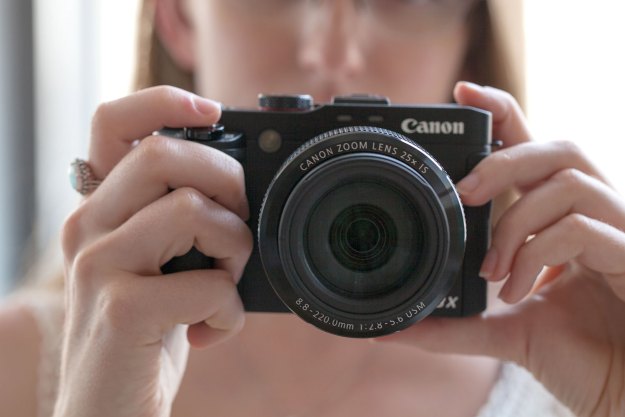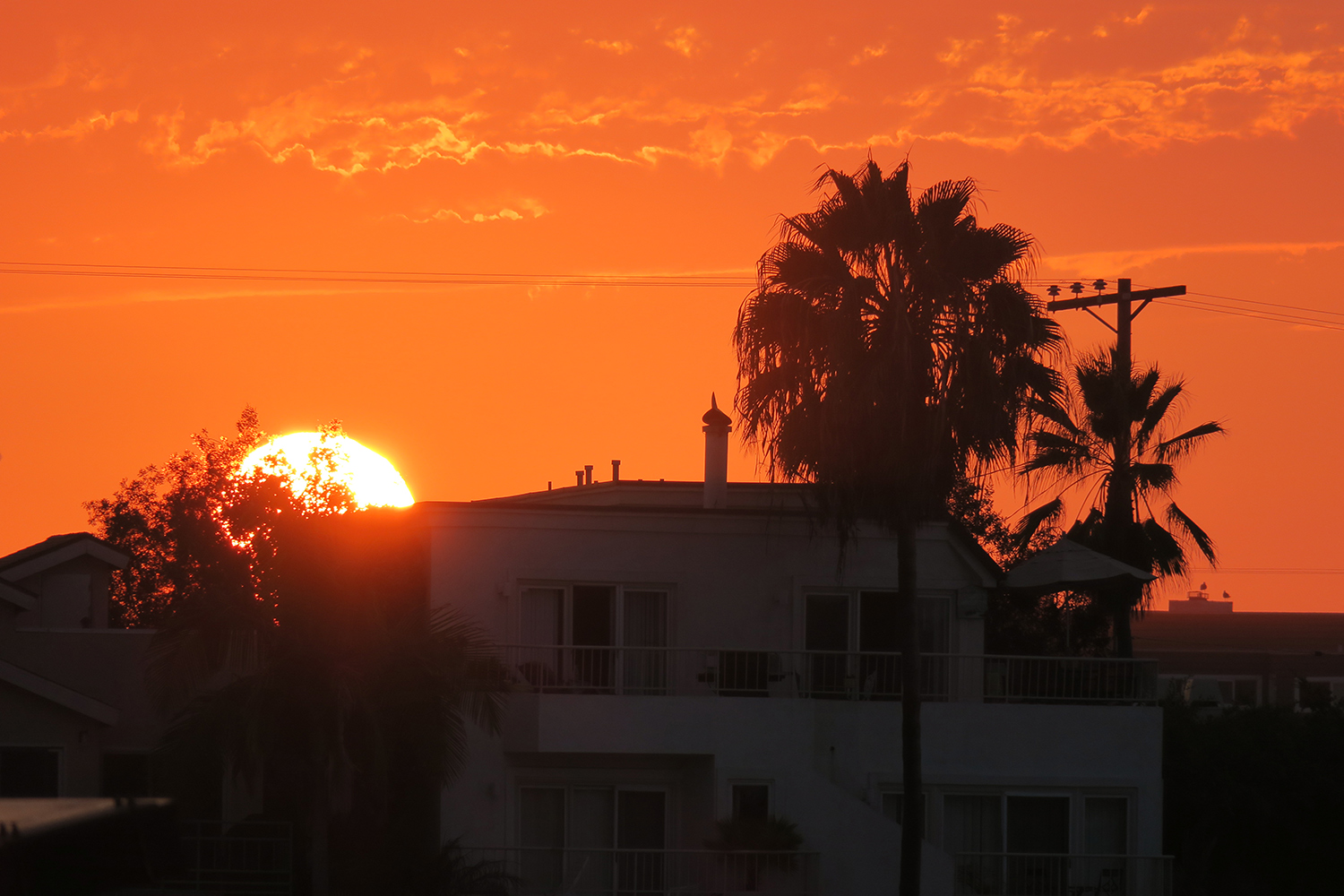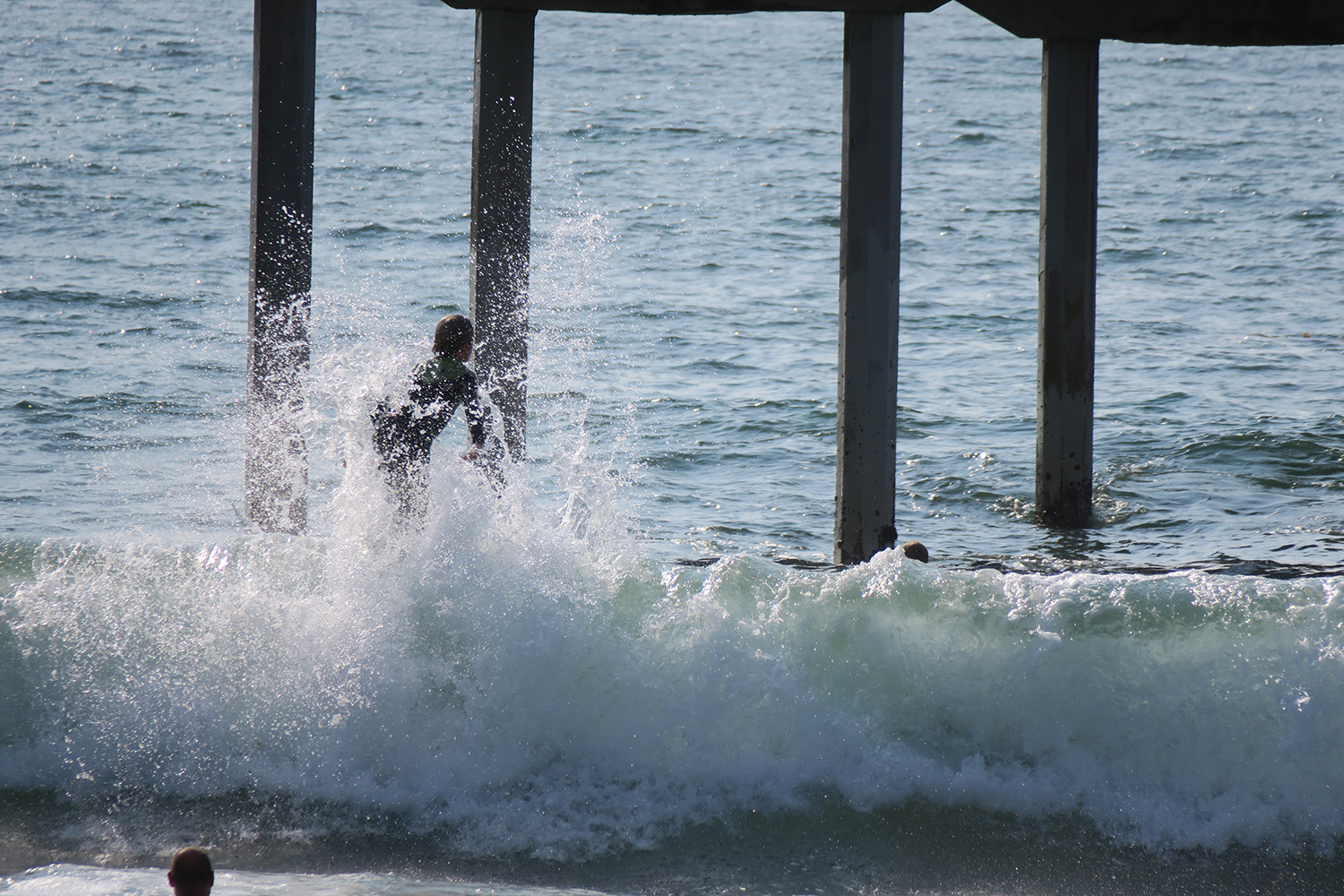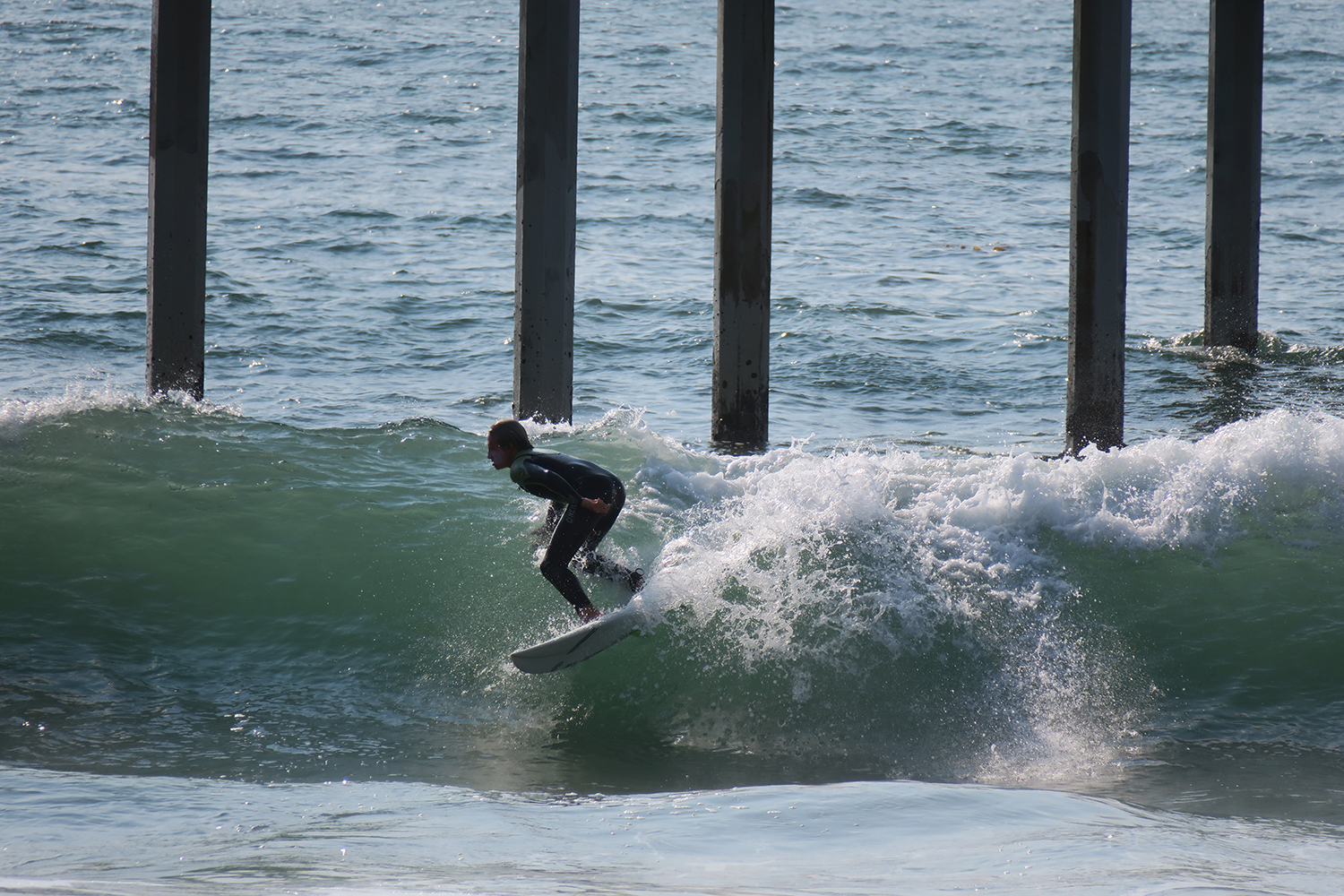
“With a 1-inch sensor and 24x zoom, the PowerShot G3 X is an excellent mega-zoom camera worthy of enthusiasts.”
- Tremendous 24-600mm range
- Excellent 20.2MP stills
- High-quality 60p movies
- Responsive at 5.9 fps
- Expensive
- No viewfinder
- Poor ISO sensitivity
Buy it now from:
When it comes to popular mega-zooms, Canon recently upped their game with the 25x PowerShot G3 X ($1,000). Rather than looking like an ersatz DSLR (such as the $550 65x PowerShot SX60 HS), the new model feels and performs more like the G-series, a line of high-quality cameras that enthusiasts have loved for years. With its 1-inch sensor the G3 X captures beautiful photographs, and it’s not too shabby at videos either. But tourists looking for a strong all-in-one camera or enthusiasts who want a capable secondary shooter, the G3 X is a compelling option.
Features and design
The all-black G3 X is much more angular than Canon’s current SX-series of mega-zooms (also known as “bridge” cameras) and it has a distinct rangefinder vibe. What makes it stand apart from rest of the G-models is the huge lens on the front. Where other G-series cameras max out at 4x or 5x optical zooms, the G3 X has a range of 24-600mm, or 25x, with a maximum aperture of f/2.8 (wide angle) to f/5.6 (telephoto). Also adding to its appeal is a large 20.2MP 1-inch sensor – just like G7 X, and far larger than the 1 /2.3-inch imager used in the SX-series. In a nutshell, larger sensors mean better photos with improved detail. Sony’s Cyber-shot RX10 and RX10 Mark II are the only other mega-zooms with 1-inch sensors and their focal range is only 24-200mm (8.3x). You may think the G3 X has the Sony beat but the RX10s have a constant aperture f/2.8 lens and performs some very cool tricks. Before we get into comparisons, let’s look at what else this Canon has to offer.
We had high expectations in image quality, and we weren’t disappointed.
The dust- and water-resistant G3 X is big and feels very substantial, and there is no mistaking it for a pocket cam. The grip has a nicely textured finish and, during testing, felt comfortable in our hands (as always, you should do your own heft-and-feel test). The G3 X measures 4.9 x 3 x 4.2 inches (WHD) and weighs 1.62 pounds (fully loaded with battery and card). That 4.2-inch spec for depth is with the camera off; fully extended, the camera is around 7 inches. Seriously, this one is really for vacationers who want an all-in-one camera they don’t mind lugging around, especially when compared to the huge weight of a DSLR with a bag full of lenses.
The lens is optically stabilized and uses USM (Ultra Sonic Motor) technology to eliminate noise when zooming – a plus when shooting videos. On the front you’ll also find an AF-assist lamp for focusing in dim light and stereo mics. On the left side of the lens barrel are two buttons, one for manual focus (MF) and Framing Assist Seek. The latter is an excellent feature: It helps you find your subject at extreme telephoto, since any slight movement can easily lose track of what you’re trying to zoom in on. Tap this button and the lens will zoom back; a shaded box appears so you can re-center what you want to capture. This came in very handy shooting surfers catching some waves, for example. (More about the lens performance below.)
The top deck has a built-in pop-up flash, a hot shoe, main mode dial, power on/off key, exposure compensation dial, jog wheel to adjust menus, and a red-dot video button. On top of the grip is the shutter surrounded by the zoom lever. These controls are logically placed but we’d prefer the video button to be raised a bit more above the surface.
The dominant feature on the back is a 3.2-inch tilting touchscreen LCD, rated 1.62-million dots – possibly the highest quality display we’ve seen yet. It definitely has reflectivity issues in direct sunshine but you can correct this by cranking up the brightness via the menu system. If you want to eliminate these problems completely, Canon has an optional electronic viewfinder (EVF) that attaches via the hot shoe, for $300. By comparison, the Sony RX10 has a built-in EVF.
Other features on the back include a smartphone button to link the camera to your phone or other mobile device using the Canon app (there’s also an NFC tag on the left side of the body, for use with select Android devices and Canon’s optional Connect Station accessory). To the right of the LCD is a large, textured thumb-rest to help keep the camera steady, as well as a collection of keys (shortcut, delete, AF Frame Selector, playback, menu, and display). A control wheel surrounds a center Q/Set button. The Q button pulls up the camera’s adjustable parameters onscreen, such as white balance. The four points of the dial let you change the flash, AF/burst, macro, and ISO. This control layout is very typical of the G-series and is designed for enthusiasts comfortable tweaking their shots.
On the right side is a compartment with connections for a remote, USB, and HDMI, while the left-side compartment has inputs for headphones and a mic. Also on the left is a switch to manually pop the flash up. The bottom has a tripod mount and battery/SD card compartment.
What’s included
Canon supplies the camera, plug-in charger, and a battery (rated a solid 300 shots). You also get a neck strap and a lens cover. Also provided is a 131-page quick-start guide; the full manual is available as a download, as is a basic software bundle for handling files.
Warranty
Canon offers a typical one-year warranty for parts and labor. Canon offers an extended warranty plan, called CarePak Plus ($110-$150), which covers accidental damage and offers live support. Since the camera is on the pricey side, you may want to consider this option.
Performance and use
The G3 X uses a 1-inch 20.2MP sensor that captures 5,472 x 3,648-pixel photos (JPEG/RAW). The photos this sensor is capable of look terrific. We had high expectations, and we weren’t disappointed. Colors were right on target for the most part. When we wanted a little more pop, a simple turn or three of the exposure compensation dial took care of business.
The Canon Digic 6 processor helps speed things along; the top speed is 5.9 frames per second (fps). We put this to the test shooting surfers off the coast of San Diego (see samples). The camera has a 31-point autofocus system so we rarely had any issues grabbing focus. Shutter speed range is 15-1/ 2,000th of a second (bulb setting), which is an OK range but Sony’s RX10 hits 1/3,200th.
The camera has an ISO range of 125-12,800 – about as good as it gets for a non-interchangeable lens camera. Unfortunately, the G3 X is not a great performer in low light, with noise appearing at ISO 1,000 and slowly degrading as we raised the setting. Going beyond 2,000 is asking for trouble and anything higher is problematic. This was rather surprising given Canon’s track record. Just realize you’ll need to use the flash in really dim situations. The built-in flash is a good one and worked very well for some portraits taken with the forced-flash setting.
A blemish is poor ISO performance, so try to illuminate your subject in low light.
We have to say the G3 X has an excellent feel. However, shooting at extreme telephoto requires good techniques like bracing the camera or using stable surfaces or a tripod whenever you can. The camera has a very good optical image stabilization system but even the slightest movement will have your target subject jumping around the LCD screen – if you can even find it again. That’s why the aforementioned Framing Assist button is handy. A monopod would be a good purchase for anyone serious about 600mm photographs or those doing a lot of panning while shooting movies.
The G3 X can be as simple as full automatic or as advanced as full manual. The mode dial offers Smart Auto, Hybrid Auto (creates a digest movie when shooting stills), PASM, two custom options, special effects, sports, scene (six choices), HDR (high dynamic range), and movie. We did a lot of shooting in Smart Auto but gave Program AE and Aperture Priority workouts as well. Regardless of the modes, the G3 X delivered excellent stills and we don’t think many photographers will complain about the quality.
We’re glad to see Canon offers Full HD 1080 at 60p movie recording. Focusing was accurate for the most part but it did lose the main subject on more than one occasion. Overall the results were good with nice colors and no hint of rolling shutter. Our biggest problem was panning at extreme telephoto, as we lost the subject even as we tried to keep the camera level as we moved.
The G3 X has built-in Wi-Fi and NFC connectivity. Press the smartphone key on the back of the camera and you can pair devices fairly quickly after you’ve loaded the Canon app. We had no problem connecting to a Samsung Galaxy S5 and posting photos to Facebook. The Camera Connect app offers the basics: sharing with the phone, remote shooting, and the ability to add location information to your shots. Compared to Canon’s first attempts, the latest wireless implementation is much improved.
Conclusion
DT accessory pack
SanDisk Extreme Pro SDXC (64GB) ($53)
A high-speed, high-capacity card is a key purchase.
Manfrotto 685B NeoTec Monopod ($184)
A monopod is ideal for smooth panning and overall support, particularly at full telephoto.
Canon EVF-DC1 Electronic Viewfinder ($231)
The add-on EVF is pricey, but it will come in handy.
The PowerShot G3 X is an excellent mega-zoom camera that’s far stronger than the company’s SX series – it makes sense since the SX is designed for casual shooters, while the G-series cameras are for advanced users. If you want quality and can afford the $1,000 price tag, you consider the G3 X over the SX series. The 20.2MP 1-inch sensor really does the job, plus focusing and response is quick and accurate. And let’s not forget that extremely useful 24-600mm focal range that’s good for everything from close-ups to faraway objects.
There are a few negatives, namely the lack of an EVF and relatively poor ISO performance, but overall this model does the G-series proud. A competing product would be Sony’s RX10. You’ll give up some zoom power, but it has a constant aperture f/2.8 lens and a built-in EVF.
Highs
- Tremendous 24-600mm range
- Excellent 20.2MP stills
- High-quality 60p movies
- Responsive at 5.9 fps
Lows
- Expensive
- No viewfinder
- Poor ISO sensitivity


















